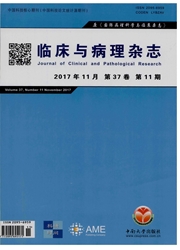

 中文摘要:
中文摘要:
目的:总结应用达芬奇机器人手术系统行胃癌根治术的经验,评价其手术效果及应用价值。方法:回顾性分析我科2011年11月至2014年11月手术治疗的250例胃癌患者的临床、病理资料。其中机器人手术126例,腹腔镜手术124例,比较两组患者手术情况及短期疗效。结果:与腹腔镜组相比,机器人组患者术中失血量少、淋巴结清扫数目多、手术时间长,比较差异有统计学意义(P〈0.05);术后胃肠道功能恢复时间、术后住院时间及并发症发生率,比较差异无统计学意义(P〉0.05)。中位随访17.2(3-30)个月,机器人组复发转移10例,死亡3例;腹腔镜组复发转移12例,死亡2例。结论:达芬奇机器人手术可在微创条件下实现胃癌的标准D2根治术,手术操作安全,临床效果确实。
 英文摘要:
英文摘要:
Objective: To summarize the experience of radical gastrectomy operation of Da Vinci system, evaluate its effect and application value. Methods: The clinical and pathological data of 250 patients with gastric cancer in our department from Nov 2011 to Nov 2014 were retrospectively analyzed. A total of 126 patients who experienced robotic gastric cancer and 124 patients who underwent Laparoscopic gastric cancer enrolled in this study. ~he operative data and short-term postoperative outcomes were compared between the groups. Results: Compared with the laparoscopic group, the robotic group had less intraoperative blood loss, larger numbers of retrieved lymph nodes and longer operation time, and the differences were statistically significant (P〈0.05). There were no significant differences in gastrointestinal function recovery time, postoperative hospital stay, and complications between the groups (P〉0.05). During a mean follow-up period of 17.2 (range, 3-30) months, 10 patients experienced relapse and metastasis, 3 patients died of the disease in robotic group, while 12 patients experienced relapse and metastasis, 2 patients died of the disease in laparoscopic group. Conclusion: With da Vinci robotic system, the standard D2 gastric cancer radical surgery can be accomplished successfully. It is feasible and safe, and the clinical effect is reliable.
 同期刊论文项目
同期刊论文项目
 同项目期刊论文
同项目期刊论文
 期刊信息
期刊信息
